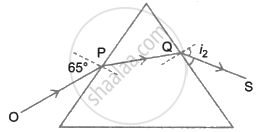Advertisements
Advertisements
Question
Solution
APPEARS IN
RELATED QUESTIONS
A ray of light incident at an angle of incidence i1 passes through an equilateral glass prism such that the refracted ray inside the prism is parallel to its base and emerges at an angle of emergence i2.
- How is the angle of emergence ‘i2’ related to the angle of incidence ‘i1’.
- What can you say about the angle of deviation in such a situation?
How does the angle of deviation depend on the refracting angle of the prism?
An object is viewed through a glass prism with its vertex pointing upwards. Draw a ray diagram to show the formation of its image as seen by the observer on the other side of the object.
A ray of light is normally incident on one face of an equilateral glass prism. Answer the following:
What is the angle of incidence on the first face of the prism?
A ray of light is normally incident on one face of an equilateral glass prism. Answer the following:
What is the angle of refraction from the first face of the prism?
What should be the angle of incidence for a ray of light which suffers a minimum deviation of 36° through an equilateral prism?
[Hint: A = 60°, i = (A + δmin)/2]
How will you use two identical prisms so that a narrow beam of white light incident on one prism emerges out of the second prism as white light? Draw the diagram.
Draw a ray diagram showing the dispersion through a prism when a narrow beam of white light is incident on one of its refracting surfaces. Also indicate the order of the colours of the spectrum obtained.
The angle between two plane rectangular refracting surfaces of a prism is called as
The diagram below shows the ray OP travelling through an equilateral prism of a certain material.
- Calculate the value of i2, if the angle of deviation is 43°.
- What is the ray QS called?

